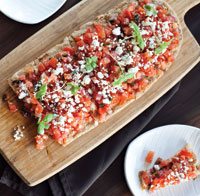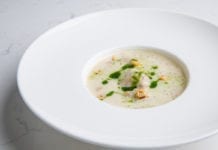Pickle Barrel has been a fixture on Toronto’s restaurant scene for more than 40 years. And, some seven years ago, a vision to offer diners healthier food options became a reality with the help of Rose Reisman, a nutritional consultant, celebrity cookbook author and caterer, who is the name behind the city’s Glow Fresh Grill and Glowpress at Dine on 3 Yorkdale. Reisman’s philosophy of leading a healthy, balanced lifestyle is evident on Pickle Barrel’s menu. In fact, her celebrity and nutritional expertise guided the development and enhanced the popularity of Pickle Barrel’s limited-time promotional gluten-free menu.
Recently, F&H caught up with the face behind the scenes, Peter Higley, president of Pickle Barrel. The leader discussed the brand’s healthy-eating innovations and its newer Glow Fresh Grill concept.
F&H: What influenced your decision to be become an early advocate of healthful menu items?
Peter Higley: Our philosophy has always been about providing a comfortable, fun atmosphere with quick, efficient and friendly service, fantastic food and unbelievable value. Beginning in 1971, we were about comfort and fun foods for people eating out. But, about seven years ago, we started to see changes in what our customers were requesting. It’s very important for us to be on trend, so we launched our Pickle Barrel ‘Art-of-Living-Well’ menu with all items [containing] about 500 calories each. It was more popular with our female customers at first, but that started to change. Pickle Barrel was one of the first to offer a burger without a bun. Rose Reisman’s signature Sun Dried Tomato burger [without a bun] is featured on our ‘Art-of-Living-Well’ menu [which has] calories identified on the menu. Our Greek Feta Burger on our regular burger menu is also identified as a Rose Reisman signature item, implying a healthier choice; it’s also served without a bun.
F&H: How do you promote healthier items to your Pickle Barrel customers?
PH: At first, healthier items were denoted on the menu. People took to it. More recently, with Rose Reisman’s help, we have developed a complete gluten-free menu. She worked with Pickle Barrel’s chef to perfect gluten-free menu items that are delicious and suitable for anyone, whether they have a gluten sensitivity or intolerance. Her approach is to [offer] food everyone at the table can eat. The gluten-free menu features a lot of fresh foods and innovative gluten-free carbohydrates like corn-based pasta, quinoa and pulled pork on a bed of mashed potatoes. There are no gluten-containing grains [such as wheat — including kamut and spelt — barley, rye and triticale or even oats, which may contain gluten through cross-contamination with menu items].
F&H : Has Pickle Barrel’s “Art of Living Well” or “Gloriously Gluten-free” menu led to increased sales?
PH: It has been more about doing the right thing — offering a choice. We have a kids’ menu that features fresh fruit, because parents wanted to ensure better choices for their children when eating out. Fruit is, of course, more expensive, especially on a great value kids menu. We also continuously tweak our ingredients to use only omega-3 eggs and zero trans fat. These are things we must do to provide the choices our customers are looking for. It’s simply a must to sustain your business — to have the choices customer want, and listen to their requests. More and more they want healthier choices and gluten-free menu selections.
F&H : So, how have you achieved success with healthy menu items?
PH: Staff training is key. Our staff is trained to know about the better quality ingredients we are using. [What’s more,] we make our food from scratch on the premises, we shop at The Toronto Food Terminal two to three times per week, and we have great food photography on the menu. The fresh, healthy items look terrific. We use our menus as a means of communicating with our customers, not only about the menu items, but we provide them with information to help them understand why we are offering the foods we [offer]. Our relationship with Rose Reisman has been invaluable to not only offering healthier choices but understanding how to develop recipes that are healthy and taste fantastic. Her philosophy of eating well and living well resonates with our customers and staff.
F&H : When it comes to healthy food options, are there any areas where Pickle Barrel and/or Glow fall short?
PH: We know the sodium content is high in our corn beef and Montreal smoked meat; it’s just the reality of those products — they remain very popular. About 65 per cent of the menu items at Glow are truly healthy choices. We have really healthy selections available and promote them using Rose Reisman’s celebrity. We don’t need to promote the smoked-meat sandwiches [at either restaurant]. People choose what they want to eat. When they are eating out they want choice, and we provide that choice.
F&H : What are your future plans for the company with regard to healthy eating?
PH: Our philosophy of fantastic food and unbelievable value is not going to change. We will continue to watch food trends and be on trend. Healthy eating is on trend.
The Analysis
Pickle Barrel’s gluten-free menu wins points for its fresh ingredients and tasty combinations. The regular menu itself is especially helpful, because each food category includes information about how to ensure side dishes and sauces are served gluten-free. For example, the Pan-Seared Atlantic Salmon is accompanied by the following notes: “Please request no sauce or seasoning on the salmon” and “request to change the accompaniment of potatoes and vegetables to a simple julienne vegetable stir fry with oil and garlic.” Most customers who have a gluten intolerance will be aware of these cautions, but notes directly on the menu alert diners to the hidden calories, sodium and fat in the side dishes and sauces.
Pickle Barrel is making inroads to promote healthier eating, and foodservice operators should take note of the chain’s decision to use a celebrity nutritionist as consumers often take advice from professionals they know and trust.
Next Steps
In April, a report by Toronto Public Health advocated developing legislation to require restaurant chains to include caloric and sodium counts on their menus, since studies show diners underestimate the calories and sodium in their restaurant meals. And, while Pickle Barrel provides some caloric information on its menu, it only lists lower calorie choices. What’s more, Pickle Barrel lists nutrition information for all its menu items online, but since the information is not shown on the menu, it’s not likely to be seen by most diners.
Salt is another concern at Pickle Barrel. On the chain’s website, items that have 3,000 mg or more of the mineral are flagged, but this is an excessive amount of sodium and requires attention. The restaurant’s smoked meats are prepared with salt brines and are noticeably high in sodium as are the pickles served. So, since Pickle Barrel staff makes its deli meats, management should reassess the original recipes to see where salt can be cut. Consumers only have to look to Pillers and Maple Leaf deli meats to see that it’s possible to significantly lower salt content in the brine and still preserve the great taste.
Every other month the “We’ve Analyzed This” column offers insight into healthy menu initiatives at various restaurants. It’s written by registered dietitians from the Oakville, Ont.-based Food Systems Consulting Inc., a Canada-wide consulting group specializing in healthy eating away from home. For more information, visit foodsystems.com.
Keep Reading
The Great Restaurant Menu-Labelling Debate Continues
Dissecting the Foodservice Sustainability Trend
Global Tastes Collide: Ethnic Fusion Is Heating Up In Canada





















